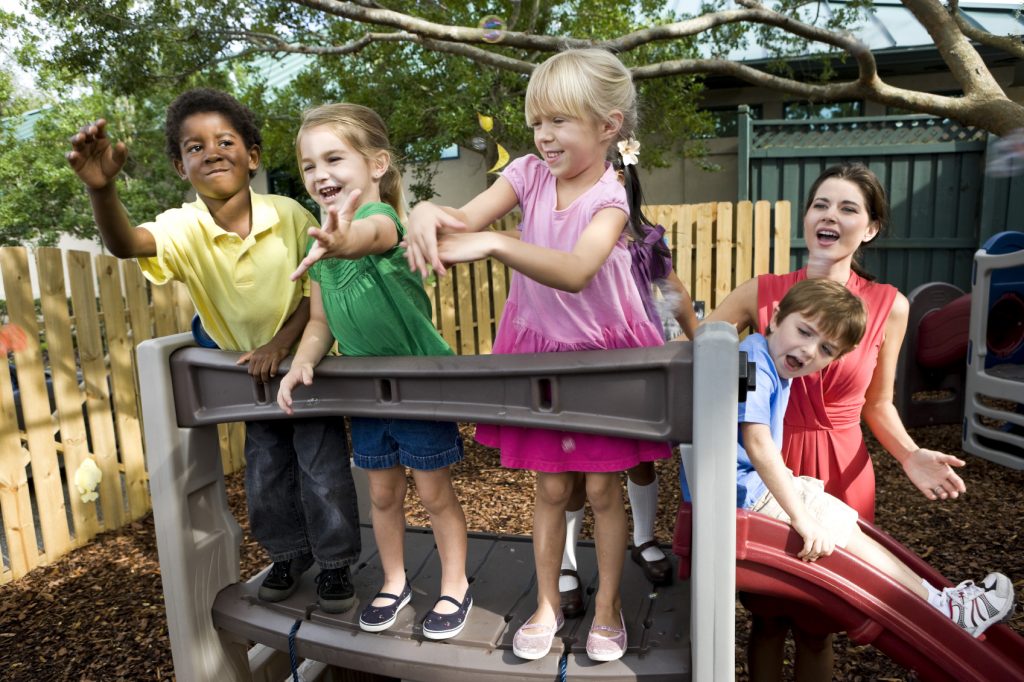Community playgrounds

Built playgrounds have equipment such as swings, slides and climbing bars. Before your child begins exploring, check the playground for safety features and any hazards.
Make sure the playground has:
- A deep, soft surface instead of a dirt or grass surface. Check for sand, pea gravel, wood chips or rubber. For preschool equipment, the fill should be at least 15 cm (6 inches) deep. For all other full-sized equipment, the fill should be at least 30 cm (12 inches) deep.
- Good handrails, barriers and railings to prevent falls.
Watch out for:
- Areas where your child’s head or neck could get stuck. Spaces might be big enough for your child’s body but might trap their head or neck. This could strangle your child. Safe spaces are smaller than nine cm (3.5 inches) and larger than 22.5 cm (nine inches). For instance, check the spaces between the steps on a slide and spaces between railings.
- Sharp objects such as broken glass, garbage, sharp edges and bolts that stick out. Pick up any glass or garbage before your child plays. If your child is old enough, teach them to stay away from sharp edges or bolts.
Backyard playgrounds
Properly anchor purchased or homemade playground equipment.

- Home playground equipment is usually lighter than public playground equipment. This means it needs to be anchored to prevent it from tipping over or collapsing. Always check the manufacturer’s guide for anchoring instructions.
- Cover or hide anchors so they don’t become tripping hazards.
Prevent falls from heights on playground equipment.
- Make sure playground equipment has guardrails or barriers that prevent falls.
- Some children are capable climbers but don’t help children to climb higher than they feel comfortable going.
Provide deep, soft surface to cushion falls and prevent many injuries.
- A deep, soft surface will cushion falls and prevent many injuries.
- Provide a loose-fill surface, such as sand or wood chips, under swings, climbers and slides. Fill should be at least 15 to 30 centimetres (six to 12 inches) deep, depending on size of equipment.
- Higher equipment needs deeper surfacing.
Remove or repair areas that can catch children’s clothing.
- Check that your child is not wearing anything that could be a choking hazard on play equipment, such as drawstrings, scarves, or helmets. These can easily become entangled in the equipment.
- Pay close attention to areas where clothes may be caught, including the top of slides, S-shaped hooks on swings, the joints of climbers and nearby fencing.
Inspect your home playground regularly.
- Make repairs or remove broken equipment. Look for signs of wear, splintering or cracks.
- Check that bolts are tight and equipment is still well anchored.
- Check the depth of surfacing – add more surfacing where necessary and rake surfacing to keep it loose and free from debris.
Ensure there’s enough space around equipment.
- The CSA Playground Safety Standard recommends that there be 1.8 metres (six feet) between any two pieces of play equipment, as well as between equipment and fencing or other structures. Swings and slides require even more space.
- Many backyards will not allow this much space, so you may need to adjust your design. Keep spacing in mind when you plan your yard and playground.
Look for standards for backyard play structures.
- Playground standards are beneficial in addressing engineering-related issues, such as structural integrity.
- For backyard and indoor settings, equipment manufacturers and installers often refer to standards published in the United States by the American Society for Testing and Materials (ASTM). ASTM has a voluntary standard for home playgrounds called Standard Consumer Safety Performance Specification for Home Playground Equipment (ASTM/F1148–22).
- Many ready-for-assembly play sets sold in Canada and the U.S. comply with ASTM safety standards. If you are buying outdoor playground equipment, look for a set that complies with the ASTM standard. Follow the manufacturer’s instructions for safe installation.
- In Canada, the Canadian Standards Association (CSA) created a set of standards for safer playground design. The CSA standard does not apply to home playgrounds but similar rules can be applied to designing safer play spaces at home.
